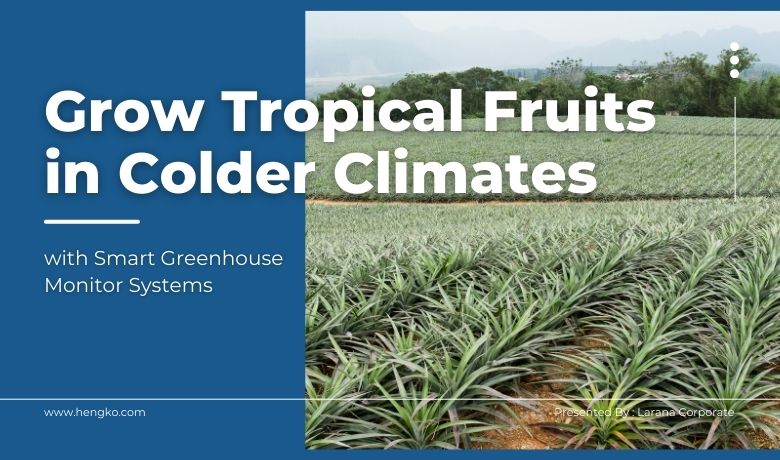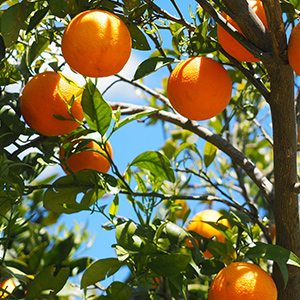- Home
- News
- Overcoming Challenges to Grow Tropical Fruits in Colder Climates with Smart Greenhouse Monitor Systems
Overcoming Challenges to Grow Tropical Fruits in Colder Climates with Smart Greenhouse Monitor Systems

Tropical fruits are known for their delicious taste and vibrant colors. However, they are typically grown in warm, tropical climates, making it challenging to cultivate them in colder climates. Fortunately, advances in greenhouse technology and monitoring systems have made it possible to grow these fruits in unexpected places. In this blog post, we will explore how smart greenhouse monitor systems can help overcome the challenges of growing tropical fruits in colder climates.
With the develop of greenhouse, it’s not just growing vegetables, but also can do the Off-season planting. In the north, it can plant the tropical fruit such as Pitaya, papaya, banana, passion fruit and loquat.
In the crop growing period, the soil, light and temperature is important. The plant environment for Tropical fruits are strict. It is usually above 25℃.
Want to learn the real-time environment change of greenhouse, just use the HENGKO smart agriculture greenhouse monitor system. HENGKO agriculture IOT temperature and humidity monitor system not only can collect the real-time data of air humidity and temperature, light, soil moisture, and water, but also monitor the sulfur dioxide, nitrogen dioxide, carbon monoxide, ozone and other gas environmental parameters.
Why Tropical Fruits Can Be Planted in the North
For a long time, there has been a perception that tropical fruits can only grow in warm, tropical climates. However, that is not the case anymore. There are many examples of successful cultivation of tropical fruits in unexpected places all over the world. For example, Japan has been successful in growing tropical fruits like mangoes and passion fruit, while Canada has seen success with growing kiwis and figs. These successes are due in part to advancements in greenhouse technology and monitoring systems that allow growers to create a more controlled and optimized environment for their crops.
The Challenges of Growing Tropical Fruits in the North
One of the main challenges of growing tropical fruits in colder climates is temperature regulation. Tropical fruits require specific temperature ranges to thrive, and colder climates can make it difficult to achieve these optimal conditions. Another challenge is light exposure. Tropical fruits typically require a lot of sunlight, which can be scarce in colder climates, especially during the winter months. Additionally, pests and diseases can thrive in a greenhouse environment, especially when temperatures are not controlled properly.
The Role of Smart Greenhouse Monitors
Smart greenhouse monitors are a solution to the challenges of growing tropical fruits in colder climates. These systems use sensors and algorithms to track and adjust environmental factors in real-time, providing a more optimized and controlled environment for tropical fruits to grow. Specific systems like temperature sensors, humidity sensors, and light meters can help growers optimize fruit growth and increase yield. By using smart monitors, growers can achieve greater precision and efficiency in their cultivation practices.
Smart greenhouse monitors can also help growers identify potential problems in their crops early on, allowing them to take corrective measures before it is too late. For example, if the temperature or humidity levels are not in the optimal range, the smart monitor can alert the grower to take action before the crop is damaged.
Examples of Successful Tropical Fruit Cultivation with Smart Monitor Systems
Many real-world examples of successful tropical fruit cultivation in the north using smart monitor systems exist. In Japan, a farmer has been able to successfully grow mangoes and passion fruit using a smart greenhouse monitor that controls temperature, humidity, and CO2 levels. In Canada, a farmer has been able to grow kiwis and figs using a smart monitor system that controls temperature and light exposure. These examples demonstrate how smart monitors can help growers achieve greater yields and higher-quality crops.
You can check the data whenever and wherever via the Android App, We chat mini program, WeChat official account and pc. The Warning information will send to the user by message, e-mail, App informs, WeChat official account informs and WeChat mini program information. Our cloud provides more intuitive visualization large screen, 24 hours temperature and humidity data analysis, abnormal alarm analysis and big data information early-warning research analysis.
Conclusion
Smart greenhouse monitor systems have made it possible to overcome the challenges of growing tropical fruits in colder climates. By providing a more optimized environment for tropical fruits to grow, we can expand the production of these fruits in unexpected places. With the help of smart monitor systems, we can look forward to enjoying our favorite tropical fruits no matter where we live.
If you are interested in learning more about how smart greenhouse monitor systems can help you grow tropical fruits in colder climates, contact HENGKO today. Our team of experts can help you choose the right temperature and humidity sensor system for your specific needs and help you optimize your cultivation practices to achieve the best results.

